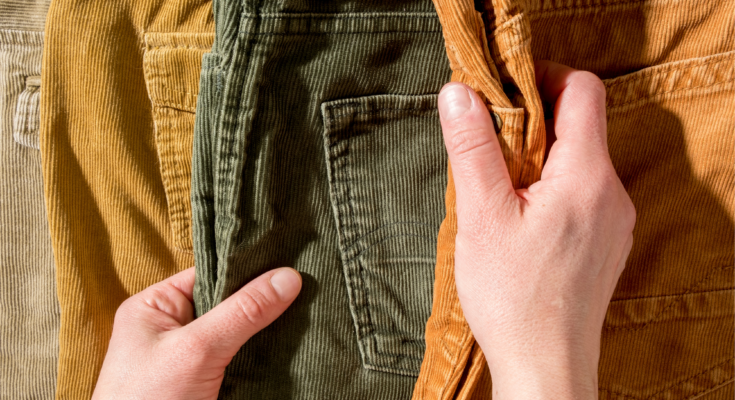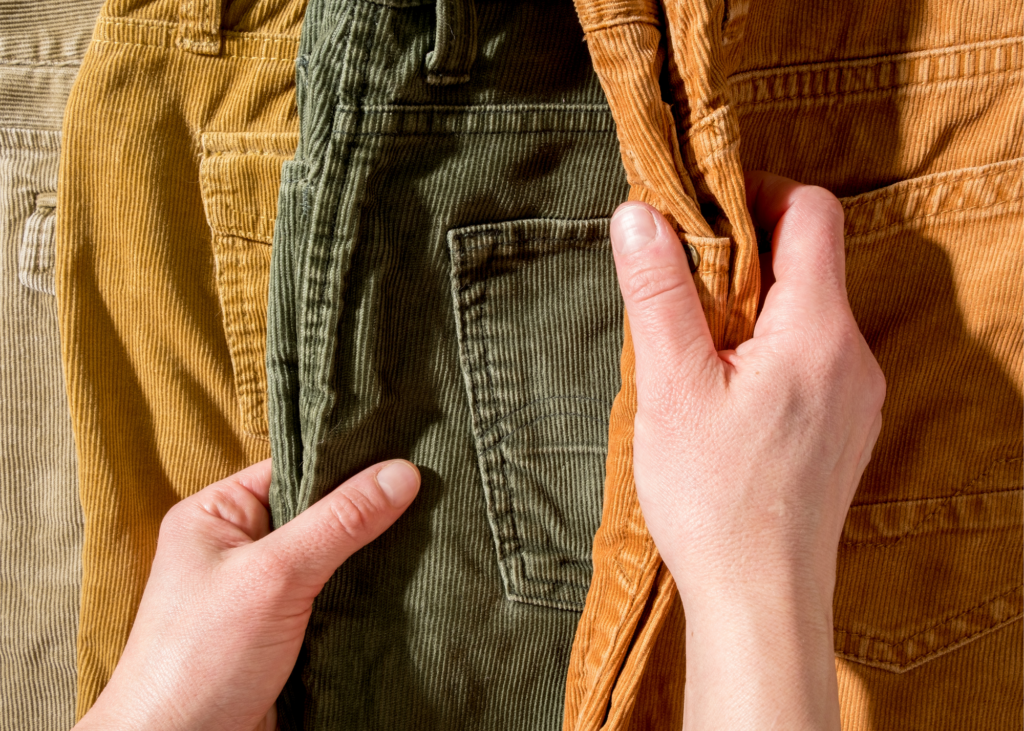Disclosure: This post may contain affiliate links. I earn a small commission when you click a link and make a purchase. Thanks for supporting SewingSociety.com!
Corduroy is a fabulous fabric — it has beautiful texture and nice structure. You commonly see it used in casual pants, skirts, and jackets.
I love corduroy, but it is not the easiest fabric to sew because it is so thick and has a nap…
In this post, I want to show you how to sew corduroy like a pro. You can master this timeless fabric!
What Is Corduroy?
Corduroy is a sturdy fabric composed of a base fabric and lengthwise stripes of matching raised tufts called, “wales.” Wide wale corduroy has broad lines of raised tufts, while pin wale corduroy has narrow wales, and the standard wale is somewhere in between.
Preparation and Care of Corduroy
Corduroy is typically made from cotton fibers and is therefore susceptible to shrinking. However, it is sometimes blended with polyester to give it some stretch.
Always preshrink corduroy fabric before sewing. Do this by washing and drying it according to the care instructions found on the fabric bolt. Please note that some corduroy fabric requires dry cleaning. If you’re not sure, run a small sample of corduroy through your washing machine to see how it stands up to the wash.
If pressing is needed, use steam and press corduroy on the wrong side over a needle board (velvet board) or a towel to avoid flattening the nap.
Layout, Marking, and Cutting Tips for Corduroy
Corduroy has a nap (one direction is up, one is down) so use the “with nap” layout in your pattern instructions. This will ensure that the nap runs the same direction for all your pieces. Also check to be sure the tops of all your pattern pieces are facing the same direction before cutting.
Pin your sewing pattern to your corduroy using long, sharp pins, such as quilter’s pins. Then, transfer all pattern markings to the wrong side of your fabric using tailor’s chalk or other fabric-safe marking tools. Tailor’s tacks of contrasting thread can be used for markings that need to be visible on the right side of your fabric.
Use sew-in interfacing to minimize the need for pressing corduroy (and the risk of flattening the pile.) For in-seam pockets, use a lining fabric instead of corduroy to minimize bulk.
Sewing Machine Setup for Corduroy
Most sewing machines are strong enough to sew through corduroy. You don’t need to buy a special, industrial sewing machine. However, a serger makes the task much easier.
- Needle: Use a jeans/sharp needle. A size 90/14 or 100/16 works best for heavy corduroy, while pin wale corduroy could use a size 80/12. A universal needle may not penetrate the thick fabric layers, leading to broken needles or skipped stitches.
- Presser Foot: A straight stitch foot or zigzag foot may be used, depending on the stitches you plan to sew. If the thick layers do not feed evenly, however, a walking foot will solve that problem. Be sure the pressure on your presser foot is adjusted to accommodate the thicker fabric. Always sew on a sample piece of fabric first to adjust your sewing machine as needed.
- Stitch Length/Width: Set your stitch length between 3.0mm and 4.0mm. Adjust up or down if needed after you sew a sample seam on some scraps of the fabric. If your corduroy has any spandex/polyester content for stretch, be sure to use a stretch stitch or a narrow zigzag stitch so your seams will stretch with your fabric.
Sewing Tips for Corduroy
If you’ve never sewn with corduroy before, take it slow and adjust your sewing machine stitch length and width until you get the desired look. Finish the raw edges of your fabric with a serger or pinking shears.
Sewing corduroy is similar to sewing denim. You don’t need a special sewing machine, but you do need to know how to deal with bulky seams. A Jean A Ma Jig can really help!
Topstitched seams and hems look great on casual corduroy. If buttonholes are part of your project, make sample buttonholes on scraps first. Then, be sure the buttons have a shank as thick as the fabric layers at your buttonhole.
When sewing corduroy, expect lint to build up in your feed dog area. You may need to take time to clean that area with a small brush periodically throughout your project. Also check the bobbin area for lint buildup.
We want to see what you’re sewing with corduroy. Leave some pics in the comments below!
Share this post on Pinterest!







2 Comments on “How to Sew Corduroy”